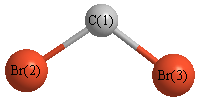Jump to
S2C1
Energy calculated at CCSD(T)=FULL/cc-pVTZ
| | hartrees |
|---|
| Energy at 0K | -5183.426192 |
| Energy at 298.15K | -5183.431220 |
| HF Energy | -5182.685122 |
| Nuclear repulsion energy | 327.911550 |
The energy at 298.15K was derived from the energy at 0K
and an integrated heat capacity that used the calculated vibrational frequencies.
Geometric Data calculated at CCSD(T)=FULL/cc-pVTZ
Point Group is C2v
Cartesians (Å)
| Atom |
x (Å) |
y (Å) |
z (Å) |
|---|
| C1 |
0.000 |
0.000 |
0.994 |
| Br2 |
0.000 |
1.544 |
-0.085 |
| Br3 |
0.000 |
-1.544 |
-0.085 |
Atom - Atom Distances (Å)
| |
C1 |
Br2 |
Br3 |
| C1 | | 1.8839 | 1.8839 |
Br2 | 1.8839 | | 3.0878 | Br3 | 1.8839 | 3.0878 | |
 More geometry information
More geometry information
Calculated Bond Angles
| atom1 |
atom2 |
atom3 |
angle |
|
atom1 |
atom2 |
atom3 |
angle |
| Br2 |
C1 |
Br3 |
110.077 |
|
Electronic energy levels
Charges, Dipole, Quadrupole and Polarizability
Jump to
S1C1
Energy calculated at CCSD(T)=FULL/cc-pVTZ
| | hartrees |
|---|
| Energy at 0K | -5183.403038 |
| Energy at 298.15K | -5183.408085 |
| HF Energy | -5182.701222 |
| Nuclear repulsion energy | 317.669098 |
The energy at 298.15K was derived from the energy at 0K
and an integrated heat capacity that used the calculated vibrational frequencies.
Geometric Data calculated at CCSD(T)=FULL/cc-pVTZ
Point Group is C2v
Cartesians (Å)
| Atom |
x (Å) |
y (Å) |
z (Å) |
|---|
| C1 |
0.000 |
0.000 |
0.712 |
| Br2 |
0.000 |
1.654 |
-0.061 |
| Br3 |
0.000 |
-1.654 |
-0.061 |
Atom - Atom Distances (Å)
| |
C1 |
Br2 |
Br3 |
| C1 | | 1.8260 | 1.8260 |
Br2 | 1.8260 | | 3.3082 | Br3 | 1.8260 | 3.3082 | |
 More geometry information
More geometry information
Electronic energy levels
Charges, Dipole, Quadrupole and Polarizability
